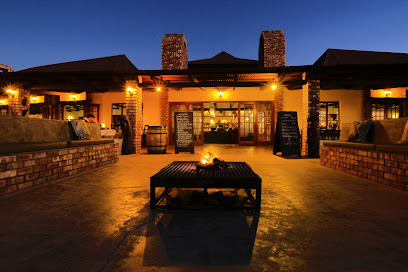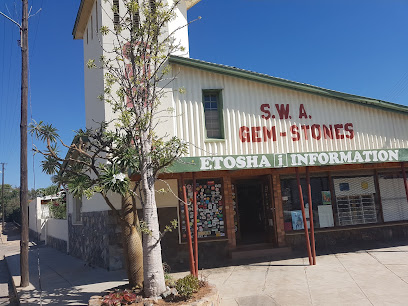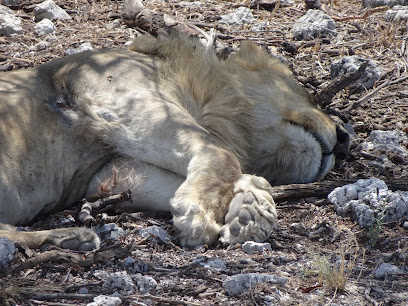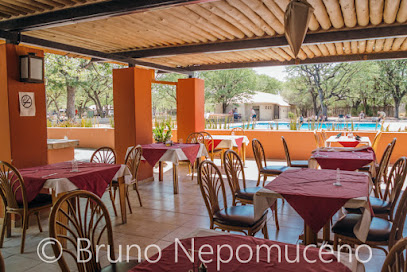
Etosha Village: Namibia's Wildlife Haven
Discover Etosha Village in Namibia, where luxury meets the wild. Experience thrilling safaris, vibrant culture, and breathtaking landscapes in one of Africa's premier wildlife destinations.
Etosha Village is a stunning tourist destination located near the famous Etosha National Park in Namibia. Known for its breathtaking landscapes and abundant wildlife, this village offers an unforgettable African safari experience. The village is a perfect blend of luxury and nature, providing visitors with comfortable accommodations amidst the wild beauty of Namibia. The nearby Etosha National Park is one of the largest game reserves in Africa, home to a diverse array of animals including elephants, lions, rhinos, and hundreds of bird species. Visitors can embark on guided game drives or self-drive safaris to witness the incredible wildlife in their natural habitat. The park's salt pan, which can be seen from space, adds a unique and surreal element to the landscape. Etosha Village also offers cultural experiences, allowing tourists to learn about the traditions and customs of the local tribes. The village markets and craft shops provide perfect opportunities to purchase authentic Namibian souvenirs. With its combination of wildlife adventures and cultural richness, Etosha Village is a must-visit destination for any traveler looking to explore the heart of Africa.
Local tips in Etosha Village
- Best time to visit is during the dry season (May to October) when animals gather around waterholes, making wildlife sightings easier.
- Book your accommodation well in advance, especially during peak tourist seasons.
- Bring binoculars and a good camera for capturing wildlife and landscapes.
- Don't forget sunscreen, a hat, and plenty of water when going on safari.
- Respect the wildlife and maintain a safe distance from animals at all times.
- Learn a few basic phrases in the local language to enhance your cultural experience.
Etosha Village: Namibia's Wildlife Haven
Etosha Village is a stunning tourist destination located near the famous Etosha National Park in Namibia. Known for its breathtaking landscapes and abundant wildlife, this village offers an unforgettable African safari experience. The village is a perfect blend of luxury and nature, providing visitors with comfortable accommodations amidst the wild beauty of Namibia. The nearby Etosha National Park is one of the largest game reserves in Africa, home to a diverse array of animals including elephants, lions, rhinos, and hundreds of bird species. Visitors can embark on guided game drives or self-drive safaris to witness the incredible wildlife in their natural habitat. The park's salt pan, which can be seen from space, adds a unique and surreal element to the landscape. Etosha Village also offers cultural experiences, allowing tourists to learn about the traditions and customs of the local tribes. The village markets and craft shops provide perfect opportunities to purchase authentic Namibian souvenirs. With its combination of wildlife adventures and cultural richness, Etosha Village is a must-visit destination for any traveler looking to explore the heart of Africa.
When is the best time to go to Etosha Village?
Iconic landmarks you can’t miss
Etosha National Park
Experience the breathtaking beauty and incredible wildlife of Etosha National Park, Namibia's premier national park and safari destination.

Etosha Safari Camp, Gondwana Collection Namibia
Experience the thrill of the wild at Etosha Safari Camp, where comfort meets the untamed beauty of Namibia's landscapes and wildlife.

Okaukuejo Etosha
Experience the untamed beauty and diverse wildlife of Okaukuejo Etosha in Namibia's iconic national park.

Etosha Safari Lodge, Gondwana Collection Namibia
Discover the ultimate safari experience at Etosha Safari Lodge, where luxury meets the wild beauty of Namibia's Etosha National Park.

Mokuti Etosha
Experience luxury and adventure at Mokuti Etosha, the perfect lodge for wildlife enthusiasts near Etosha National Park.

Toshari Lodge
Discover the serene beauty of Toshari Lodge in Namibia, your gateway to adventure and relaxation amidst stunning landscapes.

Halali Camp
Experience the beauty of nature at Halali Camp, nestled in Etosha National Park, offering wildlife encounters and serene accommodations in Namibia.

Eldorado Lodge
Discover the serene beauty of Eldorado Lodge in Ombika, your perfect escape to Namibia's wildlife and natural wonders.

Moringa Waterhole Viewpoint
Explore the breathtaking Moringa Waterhole Viewpoint, a national park paradise offering stunning vistas and rich wildlife experiences in Halali.

Etosha Pan Lookout
Discover the stunning vistas and unique wildlife of Namibia at the Etosha Pan Lookout, a breathtaking attraction within Etosha National Park.

Epacha Game Lodge & Spa
Experience the wild luxury of Epacha Game Lodge & Spa, where breathtaking landscapes meet unparalleled comfort and adventure in the heart of Namibia.

Okaukuejo Camping Area
Experience the magic of Etosha National Park at Okaukuejo Camping Area, where wildlife encounters and stunning landscapes await.

Onguma The Fort
Discover unparalleled luxury and adventure at Onguma The Fort, set within the stunning Onguma Game Reserve near Etosha National Park.

Ongava Lodge
Discover the ultimate wildlife experience at Ongava Lodge, where luxury meets adventure near Etosha National Park.

Anderson Gate Etosha National Park (Southern Entrance)
Explore the captivating wildlife and breathtaking landscapes at Anderson Gate, the southern entrance to Etosha National Park in Namibia.

Unmissable attractions to see
Okaukuejo Resort
Discover the magic of Etosha National Park at Okaukuejo Resort, where wildlife encounters and breathtaking landscapes await.

Okaukuejo Etosha
Explore the breathtaking landscapes and diverse wildlife of Okaukuejo Etosha National Park, a must-visit destination in Namibia.

Mokuti Etosha
Discover Mokuti Etosha: A luxurious lodge on the edge of Etosha National Park, blending nature and comfort for an unforgettable travel experience.

Waterberg Plateau National Park
Explore the breathtaking landscapes and rich wildlife of Waterberg Plateau National Park—Namibia's hidden gem for nature lovers and adventurers.

Halali Camp
Experience the essence of Namibia at Halali Camp, your gateway to the breathtaking wildlife of Etosha National Park.

Khaudum National Park
Discover Khaudum National Park: Namibia's hidden gem, offering breathtaking wildlife experiences and untouched natural beauty for adventurous tourists.

Tsumcor
Experience the breathtaking beauty and diverse wildlife of Tsumcor, a premier tourist attraction in Namutoni, Namibia.

Gemsbokvlakte
Experience the breathtaking views and rich wildlife at Gemsbokvlakte in Etosha National Park, Namibia's iconic natural wonder.

Namibia Gemstones
Explore the stunning world of Namibian gemstones in Outjo, where beauty, culture, and nature converge in a sparkling display.

Okondeka (natural waterhole)
Experience the breathtaking wildlife at Okondeka in Etosha National Park, where nature's beauty unfolds at every turn, creating unforgettable memories.

Okondeka (natural waterhole)
Explore Okondeka, a breathtaking natural waterhole in Etosha National Park, and witness the rich wildlife of Namibia in a serene and picturesque setting.

Rietfontein
Discover stunning wildlife views at Rietfontein Observation Deck in Etosha National Park, an unforgettable experience in Namibia's natural beauty.

Salvadora
Experience the breathtaking views of wildlife and landscapes from Salvadora in Etosha National Park, a must-visit observation deck in Namibia.

Sueda
Experience stunning panoramas at Sueda Observation Deck, where nature's beauty unfolds before your eyes in a serene and tranquil setting.

Ongava Game Reserve
Discover the breathtaking wildlife and landscapes of Ongava Game Reserve, a premier nature preserve in Namibia offering unforgettable safari experiences.

Essential places to dine
Etosha Village
Discover unparalleled comfort at Etosha Village while exploring the majestic wildlife and breathtaking landscapes of Namibia's Etosha National Park.

Etosha Village Restaurant
Discover authentic Namibian cuisine at Etosha Village Restaurant - where tradition meets flavor in a beautiful setting.

Markets, malls and hidden boutiques
Etosha Safari Camp, Gondwana Collection Namibia
Discover the beauty of Namibia at Etosha Safari Camp, your gateway to unforgettable wildlife adventures and serene lodge experiences.

Okaukuejo Etosha
Explore the breathtaking wildlife of Okaukuejo Etosha, a premier destination in Namibia's stunning Etosha National Park.

Etosha Safari Lodge, Gondwana Collection Namibia
Discover the breathtaking beauty of Etosha National Park at Etosha Safari Lodge, your gateway to unforgettable wildlife experiences in Namibia.

Etosha Village
Unwind in the tranquil Etosha Village, a perfect lodge offering comfort and adventure near the iconic Etosha National Park in Namibia.

OK Foods & OK Liquor
Explore local flavors and essentials at OK Foods & OK Liquor, Outjo's vibrant shopping mall, offering quality products and warm service.

SPAR Outjo
Discover fresh produce and local flavors at SPAR Outjo, your go-to supermarket in the heart of Namibia.

Etosha Trading Post Campsite
Discover the beauty of Namibia at Etosha Trading Post Campsite, your gateway to wildlife adventures and unforgettable experiences.

Etosha Trading Post
Explore the Etosha Trading Post - your essential stop for groceries, fuel, and tire services near Etosha National Park.

Etosha Corner
Discover the beauty and culture of Namibia at Etosha Corner, a premier event venue offering delightful dining and unique shopping experiences.

Market
Explore the vibrant Market in Outjo, a cultural hub with local crafts, fresh produce, and authentic Namibian flavors.

Images of Africa Curio Shop
Explore the vibrant culture of Namibia at Images of Africa Curio Shop, your destination for unique local crafts and authentic souvenirs.

PEP Home Outjo
Discover quality home goods at PEP Home Outjo - your one-stop shop for bedding and kitchen supplies in Namibia.

Dunns Outjo
Explore unique fashion at Dunns Outjo, a premier clothing store in Namibia, offering stylish apparel for men and women.

Garere Shop, Outjo
Explore Garere Shop in Outjo for unique local products, friendly service, and a taste of Namibian culture.

Shafa Mini Market
Experience the essence of Namibian culture at Shafa Mini Market, your one-stop destination for local groceries and unique flavors in Outjo.

Essential bars & hidden hideouts
Etosha Safari Camp, Gondwana Collection Namibia
Discover breathtaking wildlife and stunning landscapes at Etosha Safari Camp, a premier lodge in Namibia's iconic Etosha National Park.

Etosha Safari Lodge, Gondwana Collection Namibia
Experience the wildlife wonders of Etosha National Park from the comfort of Etosha Safari Lodge, where luxury meets nature's beauty.

Etosha Village
Discover the allure of Etosha Village, a serene lodge near Etosha National Park, where nature meets luxury in the heart of Namibia.

Etosha Trading Post Campsite
Discover the beauty of Namibia at Etosha Trading Post Campsite, your gateway to adventure in Etosha National Park.

Etosha Oberland Lodge
Explore the beauty of Namibia at Etosha Oberland Lodge, your perfect retreat near Etosha National Park, offering comfort, adventure, and serenity.

Etosha Trading Post
Etosha Trading Post: Your essential stop for supplies and local culture in Southern Etosha National Park.

Halali Camp Restaurant
Experience the flavors of Namibia at Halali Camp Restaurant, nestled in the heart of Etosha National Park, surrounded by breathtaking wildlife.

Spotman Bar
Experience vibrant nightlife at Spotman Bar in Onashikookaya, where local culture meets a lively atmosphere and refreshing drinks.

ETOSHA LOUNGE
Immerse yourself in the vibrant nightlife of Odimbwa at Etosha Lounge, where good drinks and great company await.

Othithiya Park Bar
Experience the vibrant atmosphere of Othithiya Park Bar in Omuthiya, where local culture meets refreshing drinks in a cozy setting.

New World Bar
Experience the heart of Omuthiya's nightlife at New World Bar, where local flavors and a vibrant atmosphere come together.

Four way Bar
Discover local culture and unwind at Four Way Bar in Omuthiya, a perfect blend of vibrant atmosphere and delicious drinks.

Etosha Village Restaurant
Experience the flavors of Namibia at Etosha Village Restaurant, a perfect stop for travelers exploring the Etosha region's stunning landscapes.

Catchup Pub & Grill
Experience the lively ambiance and diverse drink selection at Catchup Pub & Grill, a must-visit bar for every traveler in the area.

Efo-Etalala Bar
Experience the vibrant culture and hospitality of Namibia at Efo-Etalala Bar in Ondjungurume, where every drink tells a story.

Local Phrases
-
- HelloMoro
[moh-roh] - GoodbyeTotsiens
[toht-see-ens] - YesJa
[yah] - NoNee
[nee] - Please/You're welcomeAsseblief
[ah-suh-bleef] - Thank youDankie
[dahn-kee] - Excuse me/SorryJammer
[yah-mer] - How are you?Hoe gaan dit met jou?
[hoo gahn dit met yoh] - Fine. And you?Goed. En jy?
[goot. en yih] - Do you speak English?Praat jy Engels?
[praht yih eng-els] - I don't understandEk verstaan nie
[ehk verstahn nee]
- HelloMoro
-
- I'd like to see the menu, pleaseEk wil die spyskaart sien, asseblief
[ehk vil dee spees-kart seen, ah-suh-bleef] - I don't eat meatEk eet nie vleis nie
[ehk ayt nee flays nee] - Cheers!Gesondheid!
[geh-sund-hate] - I would like to pay, pleaseEk wil asseblief betaal
[ehk vil ah-suh-bleef buh-tahl]
- I'd like to see the menu, pleaseEk wil die spyskaart sien, asseblief
-
- Help!Help!
[help] - Go away!Gaan weg!
[kahn vekh] - Call the Police!Bel die Polisie!
[bel dee poh-lee-see] - Call a doctor!Bel 'n dokter!
[bel uhn duhk-tehr] - I'm lostEk is verlore
[ehk is fehr-loh-ruh] - I'm illEk is siek
[ehk is seek]
- Help!Help!
-
- I'd like to buy...Ek wil koop...
[ehk vil kohp] - I'm just lookingEk kyk net
[ehk kayk neht] - How much is it?Hoeveel kos dit?
[hoo-vel kohs deet] - That's too expensiveDit is te duur
[deet is teh duh-ur] - Can you lower the price?Kan jy die prys verlaag?
[kahn yih dee prees fuh-rahkh]
- I'd like to buy...Ek wil koop...
-
- What time is it?Hoe laat is dit?
[hoo laht is deet] - It's one o'clockDit is een uur
[deet is ayn oor] - Half past (10)Half tien
[hahlf teeyen] - MorningOggend
[oh-khent] - AfternoonMiddag
[mi-dahkh] - EveningAand
[ahnt] - YesterdayGister
[kis-tehr] - TodayVandag
[fahn-dahkh] - TomorrowMôre
[moh-ruh] - 1Een
[ayn] - 2Twee
[twee] - 3Drie
[dree] - 4Vier
[feer] - 5Vyf
[fayf] - 6Ses
[sehs] - 7Sewe
[seh-weh] - 8Agt
[ahkt] - 9Nege
[neh-ye] - 10Tien
[teeyen]
- What time is it?Hoe laat is dit?
-
- Where's a/the...?Waar is 'n/die...?
[vahr is uhn/dee] - What's the address?Wat is die adres?
[vaht is dee ah-drehs] - Can you show me (on the map)?Kan jy my wys (op die kaart)?
[kahn yih may vays (ohp dee kart)] - When's the next (bus)?Wanneer is die volgende (bus)?
[vah-nehr is dee fuhl-guhn-duh (buhs)] - A ticket (to ....)'n Kaartjie (na ....)
[uhn kahrt-chee (nah)]
- Where's a/the...?Waar is 'n/die...?
History of Etosha Village
-
Etosha Village is located near the Etosha National Park in Namibia, a region rich in natural beauty and biodiversity. The area has been inhabited by various indigenous groups for thousands of years, including the San people, who are believed to be among the earliest inhabitants. Their rock art and ancient tools provide a glimpse into the early history of the region.
-
In the late 19th century, Namibia became a German colony known as German South West Africa. The colonial era saw significant changes in the region, including the establishment of various settlements and the introduction of European agricultural practices. The German colonial presence laid the groundwork for the development of infrastructure in and around Etosha Village.
-
Etosha National Park was established in 1907 by the German colonial administration, originally covering an area of 100,000 square kilometers. It was created to protect the unique wildlife and ecosystems of the region. Over the years, the park's boundaries were adjusted, but it remains one of the largest and most important wildlife reserves in Africa.
-
Following Germany's defeat in World War I, Namibia came under South African administration as a League of Nations mandate. This period saw increased infrastructure development in the region, including roads and railways that facilitated access to Etosha Village and the surrounding areas. The South African administration also implemented policies that affected the local indigenous populations.
-
Namibia gained independence from South Africa on March 21, 1990. Since then, Etosha Village has seen significant development as a hub for tourism, benefiting from its proximity to Etosha National Park. The village has grown to accommodate a range of amenities, including lodges, restaurants, and cultural centers, making it a popular destination for both local and international visitors.
-
Etosha Village is a melting pot of cultures, reflecting the diverse heritage of Namibia. The Himba, Herero, and Owambo people are among the indigenous groups that contribute to the cultural tapestry of the area. Traditional dances, crafts, and ceremonies are an integral part of life in Etosha Village, offering visitors a unique opportunity to experience Namibia's rich cultural heritage firsthand.
Etosha Village Essentials
-
Etosha Village is located near the southern boundary of Etosha National Park in Namibia. The closest major airport is Hosea Kutako International Airport in Windhoek, about 435 kilometers away. From Windhoek, you can rent a car or book a transfer service to Etosha Village. The drive typically takes around 4.5 to 5 hours via the B1 and C38 highways. Alternatively, you can fly to the smaller Ondangwa Airport, which is approximately 200 kilometers away, and then drive or arrange a transfer to Etosha Village.
-
Within Etosha Village, transportation options are relatively limited. Most visitors prefer to rent a car to explore the area and the Etosha National Park at their own pace. Guided tours and safari drives can also be arranged through local lodges and tour operators. Public transport is scarce, so a rental vehicle or organized tour is the most practical option for getting around.
-
The official currency in Namibia is the Namibian Dollar (NAD), which is interchangeable with the South African Rand (ZAR) at a 1:1 ratio. Credit cards are widely accepted at lodges, hotels, and larger shops, but it is advisable to carry some cash for smaller purchases and tips. ATMs are available in larger towns, but it is best to withdraw sufficient cash before heading to more remote areas like Etosha Village.
-
Etosha Village and the surrounding areas are generally safe for tourists. However, standard travel precautions should be taken. Avoid leaving valuables in plain sight in your vehicle, and be cautious when walking alone at night. While the crime rate is relatively low, it is advisable to stay vigilant and aware of your surroundings at all times. Always lock your vehicle and accommodation when not in use.
-
In case of an emergency, you can dial 112 for police, fire, or medical assistance. The nearest medical facilities are located in Outjo, approximately 100 kilometers south of Etosha Village. It is highly recommended to have travel insurance that includes medical coverage. Most lodges and campsites have first aid kits and can assist in contacting emergency services if necessary.
-
Fashion: Do wear light, breathable clothing and comfortable shoes suitable for walking or hiking. Don't forget to bring a hat and sunscreen to protect against the strong sun. Religion: Do respect local customs and traditions. Avoid making loud noises or disruptive behavior at religious or cultural sites. Public Transport: Do plan your transportation in advance, as public options are limited. Don't rely on public transport for timely travel to remote areas. Greetings: Do greet people with a friendly 'hello' or 'good day.' A handshake is also common. Eating & Drinking: Do try local dishes and be open to new culinary experiences. Don't waste food, as it is considered disrespectful.
-
To experience Etosha Village like a local, visit the nearby Outjo market for fresh produce and handmade crafts. Engage with locals and ask about their favorite spots within Etosha National Park. For a unique experience, consider a night safari to see nocturnal wildlife. Additionally, plan your visit during the dry season (May to October) for optimal wildlife viewing opportunities at the waterholes.
Trending Landmark in Etosha Village
-
Etosha National Park
-
Etosha Safari Camp, Gondwana Collection Namibia
-
Okaukuejo Etosha
-
Etosha Safari Lodge, Gondwana Collection Namibia
-
Mokuti Etosha
-
Toshari Lodge
-
Halali Camp
-
Eldorado Lodge
-
Moringa Waterhole Viewpoint
-
Etosha Pan Lookout
-
Epacha Game Lodge & Spa
-
Okaukuejo Camping Area
-
Onguma The Fort
-
Ongava Lodge
-
Anderson Gate Etosha National Park (Southern Entrance)
Nearby Cities to Etosha Village
-
Things To Do in Outjo
-
Things To Do in Otjiwarongo
-
Things To Do in Oshakati
-
Things To Do in Ongwediva
-
Things To Do in Tsumeb
-
Things To Do in Omaruru
-
Things To Do in Karibib
-
Things To Do in Usakos
-
Things To Do in Okahandja
-
Things To Do in Windhoek
-
Things To Do in Swakopmund
-
Things To Do in Walvis Bay
-
Things To Do in Rundu
-
Things To Do in Mariental
-
Things To Do in Maun










